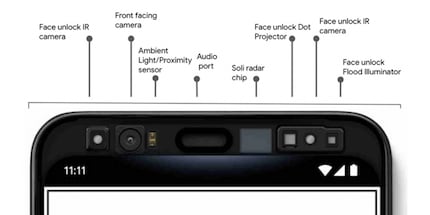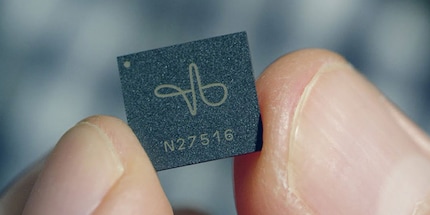
Pixel 4: Google makes gesture recognition official
Even in your pocket, the Pixel 4 should recognise your finger movements. Can you control your phone without touching it or even using the voice assistant? Now you can, thanks to the Soli chip.
Google has been working on it for five years and is set to bring it to market this year: the Pixel 4. The "Soli" radar chip can detect and recognise the movements of your fingers. So you'll be able to use your smartphone without having to take it out of your pocket or activate voice control. Google mentions in particular the ability to skip to the next audio track, stop an alarm clock or take a call.
Restricted freedom of movement
The combination of evaluation algorithms and the "Soli" chip is called "Motion Sense". According to a article on Google's blog, this feature is just the beginning. "The 'Motion Sense' feature and the possibilities it offers continue to grow, as do the Pixel phones, which have already come a long way and won't stop there.
In the US, the mobile phone will also work from your pocket. There, the competent US FCC authority has authorised the use of a more powerful radar beam than those normally permitted. "Motion Sense" will not be able to operate in all countries due to legal restrictions on radar power. It is not yet known in which countries this new feature may be implemented.
A new face?
Facial recognition to unlock your phone? Nothing new thanks to Apple and Co. But Google wants to take this functionality to a new level: the phone will activate facial recognition as soon as the user moves their hand closer to pick up the phone. Again thanks to "Soli", you'll be able to hold your phone upside down without it having any impact.

All this technology takes up space. Above the screen, Pixel 4 has a camera, the "Soli" chip, a brightness and distance sensor, two infrared lenses, a lamp and a projector to project infrared dots onto the user's face. Unconfirmed leaks put the Pixel 4's dimensions at 147 x 68.9 x 9.3mm and the Pixel 4 XL's at 160.4 x 75.2 x 9.3mm.
. Another interesting fact to note: product manager Brandon Barbello said that the photos used for facial recognition and "Soli" data are neither downloaded nor shared with other Google services.
Always smaller and more powerful
Google introduced its "Soli" project to the public at its internal developer conference Google I/O in 2015. The development team involved was originally part of Motorola. Although the Mountain View firm later sold the company to Lenovo, it retained the ATAP (Advanced Technologies And Projects) department, which was already involved in the "Soli" project.

A year later, Google reported that Infineon, a German semiconductor manufacturer, had reduced the chip to a third of its size, making it easy to integrate into a smartphone. What's more, the new chip required more than twenty times less power and only a 256th of the previous chip's computing power to detect and process gestures.
When I'm not stuffing my face with sweets, you'll catch me running around in the gym hall. I’m a passionate floorball player and coach. On rainy days, I tinker with my homebuilt PCs, robots or other gadgets. Music is always my trusted companion. I also enjoy tackling hilly terrain on my road bike and criss-crossing the country on my cross-country skis.